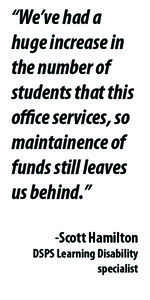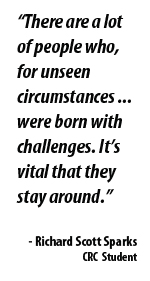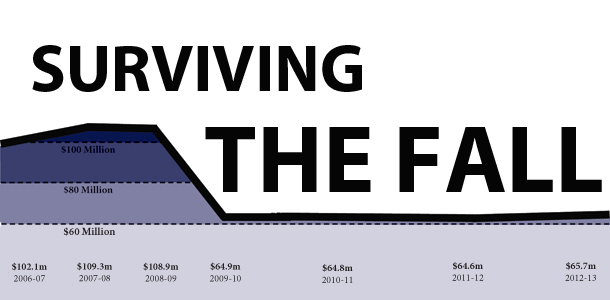Surviving the fall: How Disabled Students Programs and Services is adjusting to decreased state funding
On July 28, 2009, former Gov. Arnold Schwarzenegger and state legislators enacted the 2009-2010 California State budget, cutting funding for Disabled Student Programs and Services which served an estimated 115,461 California Community College students at the time.
Funding for categorical programs, such as DSPS, was reduced by an average of 40 percent to minimize the overall budget cuts for community colleges to approximately 13 percent, setting back years of effort to establish adequate state funding for DSPS programs.
“We were close to $113 to $115 million total [in 2009],” said Scott Hamilton, Cosumnes River College’s DSPS Learning Disability Specialist. “At that point we were getting close to having as much money as we ought to as a system to carry out what we should do.”
The total state budget for DSPS dropped to $69 million for the last four years, funding all of California’s community colleges and a handful of state funded facilities that produce alternative media such as braille.
“That was a huge mistake,” said Richard Scott Sparks, a 36-year-old behavioral science major. “There are a lot of people who, for unseen circumstances and things that happened beyond their control, were born with challenges. It’s vital that they stay around.”
Sparks is a military veteran who was stationed in the Republic of Kosovo during the late 1990s and was later diagnosed with post traumatic stress disorder, epilepsy, bipolar disorder and depression. He will complete his degree by the end of the semester and plans to pursue a career in music and sculpting. Sparks uses several of the accommodations, such as a classroom notetaker and extended time for test-taking, which DSPS offers to eligible students at CRC.
“Every single thing that they have, I’ve used, and it has all been necessary for me,” he said. “If I didn’t have the accommodations, I don’t think I would have been able to graduate.”
Though Sparks is utilizing DSPS to its full potential, the program as a whole  has faced serious challenges over the past years.
has faced serious challenges over the past years.
“When the program first came out decades ago, the funding was adequate to run the program,” said Donald G. Wallace, Phd., the vice president of administrative services and student support at CRC. “But the state, I would suggest, has a history of starting a program that the funding then dwindles away from.”
As a result of cuts to funding, districts and campuses across California compensated for the loss by pulling finances from their reserves and “reducing or eliminating services” provided by DSPS, according to a 2012 study on the Effects of Reduced Funding on DSPS by MPR Associates, a research and consulting firm on education.
The most common services eliminated from campus DSPS programs were, in order of frequency: tutoring for students with disabilities, learning disability assessment, adapted physical education, recorders and special classes,
according to the report.
The reduction of services correlated to an increase in wait time for counseling and accommodations statewide. Of the 2,348 DSPS students interviewed in the report, 26 percent said that they had to drop or withdraw from a class.
That percentage translates into thousands of dropped classes when multiplied with the number of students who utilize DSPS in California.
“Over 32,000 people theoretically would have dropped a class because they couldn’t get accommodations in time … If you’re blind and you can’t get your book, how are you going to stay in class?” Hamilton said. “Tens of thousands of people had their civil rights violated, and you’re [the state] not going to put money back into it? I don’t understand.”
So far, no services provided by DSPS have been cut at CRC and this is in part due to the use of reserve funds from the college and district, along with an effort to maintain services for students, said Celia Esposito-Noy, the vice president of student services and enrollment management at CRC
“We don’t reduce services,” she said. “We re-envision. We change how we deliver.”
* Data compiled from Cosumnes River College – DSPS budget allocations
To counteract state funding cuts over the past three years, CRC has contributed $519,099 to its DSPS program, the Los Rios district has contributed $100,564 and the Vocational and Technological Education Act provided $56,000.
However, even with the efforts that CRC and the Los Rios district have made to maintain DSPS, the program is still struggling, Hamilton said.
Between the years 2001 and 2011, students requiring services from DSPS increased by 35,000, which is approximately 39 percent, according to the MPR Associates report.
“We have to provide the accommodations and we have no idea what that is going to be from year to year, but it goes up every year,” Wallace said. “One, I think perhaps we’re getting more students that have those needs, and two, I think people are becoming aware of those services.”
This reflects a suggestion made in the study from MPR Associates stating that  the increase in DSPS students could be a result of the minimization of other categorical programs, like Extended Opportunity Programs and Services that provides support for educationally and economically challenged students, which have reduced the amount of students they service in response to a lack of funding.
the increase in DSPS students could be a result of the minimization of other categorical programs, like Extended Opportunity Programs and Services that provides support for educationally and economically challenged students, which have reduced the amount of students they service in response to a lack of funding.
Regardless of funding, DSPS cannot deny services to anyone with a disability so they maintain strict guidelines and require a full assessment before accommodations can be provided to any student on campus.
“I rarely see someone in here where there isn’t a justification for them getting an accommodation,” Hamilton said. “The problem is that we have had a huge increase in the number of students that this office services, so maintenance of funds still leaves us behind.”
In comparison to an analysis of the DSPS student population in 2001, two categories of disabilities have risen rapidly: students classified as having a
psychological disability and those categorized as having “other disabilities”,
according to the MPR report.
“There was a cutting back on the amount of learning disability assessment that has been done,” Hamilton said. “So students got classified as ‘other’ instead of making another assessment to update the situation.”
In combination with un-assessed students, those on the autism spectrum or with attention deficit disorder, attention hyperactivity and specific health conditions are all under the umbrella of “other disabilities.” The number of students in this category has more than doubled since 2001, and now comprises of more than a third of the DSPS student population, according to the MPR report.
However, there are outside factors contributing to the increase as well.
“Services out in the community have been reduced,” Esposito-Noy said. “We are the only option for many folks who are too high functioning for a day treatment program but can’t really be at a four-year college.”
With the increase in population there should come a raised awareness and understanding of disabilities from the professors at CRC being that “a disability is situational and cultural,” Hamilton said.
“There are certain teachers that are really awesome on this campus,” Sparks said. “But there are also some teachers who don’t understand and can’t see that there are students who are really trying.”
Sparks has utilized DSPS for more than two years and said he’s encountered a hesitancy from certain professors to allow accommodations.
“[Compare] a student that does a half-assed job and gets a B against a student with a disability who really tries and gets a C+, which for him is a huge success, because no one ever told him he was going to pass the class to begin with,” he said. “Understanding that dynamic is important for a teacher, and some do and some don’t.”
The administrative faculty at CRC is addressing the steadily growing  population of students who utilize DSPS by taking steps to adjust and streamline certain aspects of the program. A part of this effort is the implementation of universal design in certain classrooms, an educational and classroom format which focuses on providing information in an easy and accessible manner for students with a wide range of learning needs and abilities, Esposito-Noy said.
population of students who utilize DSPS by taking steps to adjust and streamline certain aspects of the program. A part of this effort is the implementation of universal design in certain classrooms, an educational and classroom format which focuses on providing information in an easy and accessible manner for students with a wide range of learning needs and abilities, Esposito-Noy said.
“The instructional faculty has really taken on the challenge for Universal Design,” she said. “In particular, [professor] Mary Martin in math has done a phenomenal job flipping her classroom and implementing universal design that works really well for students with disabilities.”
Sparks, a former student in one of Martin’s math classes, said he agrees.
“She is a wonderful teacher. I love Mary Martin,” Sparks said. “Her class is very hands on and she understands that not everybody learns the same. There are
teachers who are very supportive of their students and she is one of them.”
Currently, in her Math 30 class, Martin is applying an aspect of Universal Design known as flipping the classroom, where students view lectures at home and spend time in the classroom working on homework and assignments.
“I have a larger-than-normal number of DSPS students in this class and as a group their scores are solid,” Martin said in an email to The Connection. “The students are working in an environment where they have greater access to individual help, the students can tailor their “in class” work to focus on clarifying concepts and strengthening their weaknesses.”
For the first exam of the Math 30 class, two of the top three scores were from DSPS students, Martin said.
“I think the strongest impact of this format is the positive effect this class seems to be having on the student’s confidence in their own ability to be successful,” she said.
Another addition to the DSPS program is the new test proctoring room, P76, which now has a full-time test proctor and is open to DSPS students, said Dr. Michael Marion, Jr., the dean of student services and counseling.
The test proctoring room is a service that Sparks uses on a regular basis.
“It’s a really safe, calm and isolated area,” he said. “There are no outside distractions and you can really just focus on what’s in front of you.”
Currently, the DSPS offices and the test proctoring room are on separate ends of the CRC campus. However, that may change in the future.
“We are also in the process of looking at other spaces to potentially bring test proctoring and DSPS together into one central location,” Marion said.
But both Hamilton and Sparks said they believe a new DSPS facility is long overdue.
“This is the office that has been in place for over 35 years now and it’s still stuck in a portable building out back,” Hamilton said, arguing the need for a larger facility with multiple individual testing rooms and a centralized location for accessibility.
“They need to upgrade. If I was running the school, I would take money from something else and put it into that,” Sparks said.
However, even with a new facility, the DSPS program would require two full-time counselors and a learning disability specialist along with part-time staff to assist during the busy times of the year, Hamilton said.
“We don’t have a full-time counselor and we now see more than 800 students a year,” he said.
Unfortunately, only so much can be done without the adequate state funds to support the program, Dr. Marion said.
“What we’re hoping is that soon, and very soon, the economy in the state is going to pick up so
that our funding can be restored,” he said.
“That’s how practical it is.”
So while campus administrators and DSPS staff hold their breath for the coming budget proposal, some argue that the cuts in funding should have never occurred in the first place.
“If this was about race, or gender, or religion, we wouldn’t have even heard about it. It would have been taken care of, it would have been done,” Hamilton said. “But because it’s about people with disabilities, somehow, that’s acceptable.”
“I am not objective,” he said. “I try to think objectively but I can’t come up with any logical or rational reason why that is okay.”

